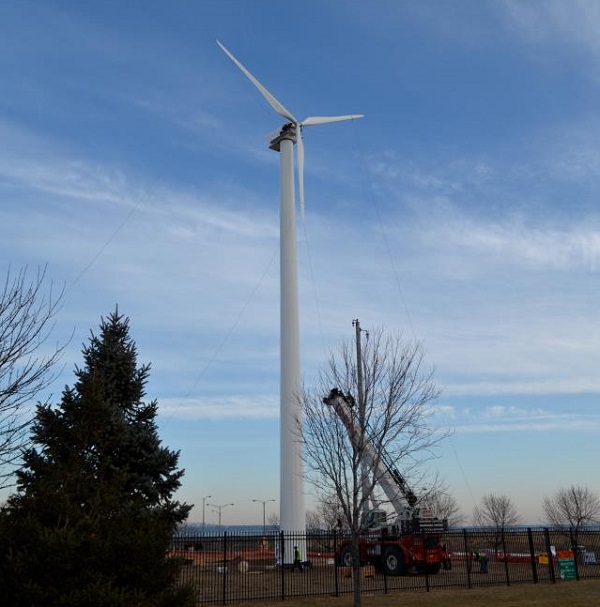This probably won’t be news to commuters who travel I-794 south from Milwaukee’s downtown. Unless you’re too busy texting, you can’t miss a 154-foot-tall wind turbine, can you?
And anyone who hasn’t seen the turbine in the real world has surely seen it virtually on the Milwaukee Office of Environmental Sustainability’s Facebook page. The agency has posted regular updates and photos about the construction of the city’s very own turbine, from the groundbreaking back in November 2011—with all those officials looking silly shoveling dirt in their suits and hardhats—to the first section of the tower going up, to the most recent, triumphant wall posting: “It’s official: the Port turbine is operational! We hope to have a public interface web page available soon so you can monitor the turbine’s real time output.”
Erected next to the Port Administration Building on Lake Michigan, the turbine is 120 feet tall to the nacelle, with the rotors reaching up to that 154 figure at the highest point in their rotation. That makes it a heck of a lot bigger than your average urban turbine, but nothing like the football-field-tall machines that comprise utility-scale wind farms.
The Port turbine can put out up to 100-kilowatts (kW) of power and the estimate is that it will produce between 109,000 and 152,000 kilowatt-hours annually. That would more than offset the Port Administration Building’s power use, which in 2010 was just barely more than 100,000 kWh.
The national average cost for electricity was about 12.7 cents per kWh in 2011, according the Bureau of Labor Statistics, so at that rate the turbine would generate between $13,843 and $19,304 worth of electricity every year. So was it a good investment? Well, it was from the city of Milwaukee’s perspective, since it didn’t have to foot the bill. Most of the approximately $600,000 cost of the turbine was paid for by federal taxpayers, with $400,000 coming from a $5.8 million Energy Efficiency and Conservation Block grant the city received from the U.S. Department of Energy as part of the 2009 stimulus.
The remainder of the costs were to be recovered “through a combination of incentives and grants from We Energies and Focus on Energy,” the city said.
[source: http://feedproxy.google.com/~r/Earthtechling/~3/PmEuUupcSEg/]



Leave a Reply
You must be logged in to post a comment.